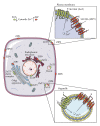Zinc transporters, mechanisms of action and therapeutic utility: implications for type 2 diabetes mellitus
- PMID: 23304467
- PMCID: PMC3530793
- DOI: 10.1155/2012/173712
Zinc transporters, mechanisms of action and therapeutic utility: implications for type 2 diabetes mellitus
Abstract
Zinc is an essential trace element that plays a vital role in maintaining many biological processes and cellular homeostasis. Dysfunctional zinc signaling is associated with a number of chronic disease states including cancer, cardiovascular disease, Alzheimer's disease, and diabetes. Cellular homeostasis requires mechanisms that tightly control the uptake, storage, and distribution of zinc. This is achieved through the coordinated actions of zinc transporters and metallothioneins. Evidence on the role of these proteins in type 2 diabetes mellitus (T2DM) is now emerging. Zinc plays a key role in the synthesis, secretion and action of insulin in both physiological and pathophysiological states. Moreover, recent studies highlight zinc's dynamic role as a "cellular second messenger" in the control of insulin signaling and glucose homeostasis. This suggests that zinc plays an unidentified role as a novel second messenger that augments insulin activity. This previously unexplored concept would raise a whole new area of research into the pathophysiology of insulin resistance and introduce a new class of drug target with utility for diabetes pharmacotherapy.
Figures


Similar articles
-
Zinc transporters and zinc signaling: new insights into their role in type 2 diabetes.Int J Endocrinol. 2015;2015:167503. doi: 10.1155/2015/167503. Epub 2015 Apr 23. Int J Endocrinol. 2015. PMID: 25983752 Free PMC article. Review.
-
Zinc transporters and insulin resistance: therapeutic implications for type 2 diabetes and metabolic disease.J Biomed Sci. 2017 Nov 20;24(1):87. doi: 10.1186/s12929-017-0394-0. J Biomed Sci. 2017. PMID: 29157234 Free PMC article. Review.
-
Cellular zinc metabolism and zinc signaling: from biological functions to diseases and therapeutic targets.Signal Transduct Target Ther. 2024 Jan 3;9(1):6. doi: 10.1038/s41392-023-01679-y. Signal Transduct Target Ther. 2024. PMID: 38169461 Free PMC article. Review.
-
Implications of impaired zinc homeostasis in diabetic cardiomyopathy and nephropathy.Biofactors. 2017 Nov;43(6):770-784. doi: 10.1002/biof.1386. Epub 2017 Aug 27. Biofactors. 2017. PMID: 28845600 Review.
-
Targeting the Zinc Transporter ZIP7 in the Treatment of Insulin Resistance and Type 2 Diabetes.Nutrients. 2019 Feb 15;11(2):408. doi: 10.3390/nu11020408. Nutrients. 2019. PMID: 30781350 Free PMC article. Review.
Cited by
-
Imaging Insulin Secretion from Mouse Pancreas by MRI Is Improved by Use of a Zinc-Responsive MRI Sensor with Lower Affinity for Zn2+ Ions.J Am Chem Soc. 2018 Dec 19;140(50):17456-17464. doi: 10.1021/jacs.8b07607. Epub 2018 Dec 11. J Am Chem Soc. 2018. PMID: 30484648 Free PMC article.
-
Effect of glycation on human serum albumin-zinc interaction: a biophysical study.J Biol Inorg Chem. 2018 May;23(3):447-458. doi: 10.1007/s00775-018-1554-8. Epub 2018 Apr 4. J Biol Inorg Chem. 2018. PMID: 29619544
-
Capsaicin and Zinc Promote Glucose Uptake in C2C12 Skeletal Muscle Cells through a Common Calcium Signalling Pathway.Int J Mol Sci. 2022 Feb 17;23(4):2207. doi: 10.3390/ijms23042207. Int J Mol Sci. 2022. PMID: 35216322 Free PMC article.
-
Zinc transporter 8 (ZnT8) and β cell function.Trends Endocrinol Metab. 2014 Aug;25(8):415-24. doi: 10.1016/j.tem.2014.03.008. Epub 2014 Apr 18. Trends Endocrinol Metab. 2014. PMID: 24751356 Free PMC article. Review.
-
Protamine zinc insulin combined with sodium selenite improves glycometabolism in the diabetic KKAy mice.Sci Rep. 2016 May 23;6:26563. doi: 10.1038/srep26563. Sci Rep. 2016. PMID: 27212152 Free PMC article.
References
-
- Charbonnel B, Cariou B. Pharmacological management of type 2 diabetes: the potential of incretin-based therapies. Diabetes, Obesity and Metabolism. 2011;13(2):99–117. - PubMed
-
- Wright EE, Stonehouse AH, Cuddihy RM. In support of an early polypharmacy approach to the treatment of type 2 diabetes. Diabetes, Obesity and Metabolism. 2010;12(11):929–940. - PubMed
-
- Jansen J, Karges W, Rink L. Zinc and diabetes—clinical links and molecular mechanisms. The Journal of Nutritional Biochemistry. 2009;20(6):399–417. - PubMed
-
- Shaw JE, Sicree RA, Zimmet PZ. Global estimates of the prevalence of diabetes for 2010 and 2030. Diabetes Research and Clinical Practice. 2010;87(1):4–14. - PubMed
-
- Youngman S. Advanced Renal Care. Blackwell Publishing; 2008. Diabetes and renal failure; pp. 122–133.
LinkOut - more resources
Full Text Sources
Other Literature Sources

